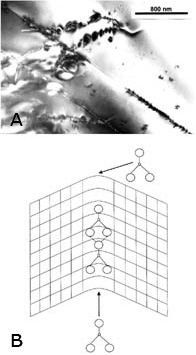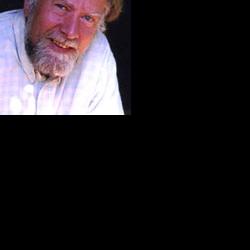Research
Mesoscopic Phenomena in Minerals

Fig. A. Premelting along twin boundaries in lawsonite (note the melt bubbles along the straight twin wall). Fig. B. Sketch of rotation hindrance during the diffusion of molecules along twin walls. Two molecules bound in the confined space with chemical bounding (broken lines) which would not occur in the gas phase.
My research focuses on a mathematically correct and physically meaningful description of microstructures in minerals. Elastic Forces generate 'universal' microstructures such as twins, needle and trumpet domains, wiggled domain walls, comb structures and tweed. The internal structures, e.g. of a twin wall, and elastic forces are atomic in origin. Atomic forces determine transport properties along twin walls, the thickness of such walls, and lead sometimes to extreme electronic properties of such microstructures. My research has lead to a new understanding of how atomic and electronic transport occurs in minerals with structural phase transition. It is also important for the understanding of premelting phenomena and the softening of elastic constants and surface structure. Recent work includes research on the encapsulation of actinites in ceramic matrices. Using computer simulation of many interacting particles (>1 million atoms) together with results from diffuse X-ray scattering, NMR and IR spectroscopy the polymerisation of minerals such as zircon during shock events and the percolation behaviour of their dissolution was identified. I am chairman of the Steering Committee of the National Institute for Environmental e-Sciences and use GRID technology for my own research, e.g for numerical studies in systems using compacification of discrete model Hamiltonians.
Highlights are the discovery of:
- superconducting twin boundaries in WO3-x, I discovered together with my collaborators,
- fast transport of Na and K along twin walls in feldspar and perovskite structures,
- heterogeneous deoxygenation along mesoscopic structures in dense packed structures,
- percolation behaviour of radiation damaged minerals and their dehydration mechanisms,
- surface softening in bones, elastic instabilities related to the movement of strain boundaries and interfaces, effective medium theories
Publications
ORCID link: https://orcid.org/0000-0002-8781-6154

